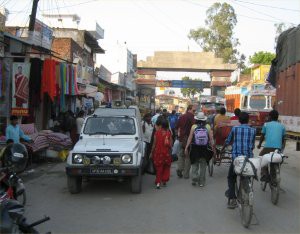 |
Dropped off by bus, we bid farewell to Indira, and walk towards the Nepalese Border.
I had read that at times, the Nepalese side was so disorganised, that a person could leave India, and end up spending several hours in “no mans land” until the border guards actually woke up.
Nothing like this happened, we got through without event. I didn’t buy a visa in advance, which saved £25. I normally do to avoid hassle, but on this occasion, I decided to save a bit of money, and it worked fine.
We meet our Nepalese guide, board our bus, and head towards the town of Lumbini in the Himalayas foothills. |
| After check in, we get cleaned up, get some food, and have an early night.
Lumbini was the birthplace of the Gautama Buddha the apostle of peace and the light of Asia in 623 B.C. (he later founded Buddhism, and is known better to westerners as the Lord Buddha).
The site is home to Monasteries from Buddhist country’s all over the world. It is in 2 zones, separated by a Canal.
East Monastic Zone is dedicated for the construction of Theravada monasteries.
West Monastic Zone is dedicated for the construction of Mahayana traditional monasteries.
The place evokes a kind of holy sentiment to the millions of Buddhists all over the world- and is the Mecca of every Buddhist, being one of the four holy places of Buddhism. |
 |
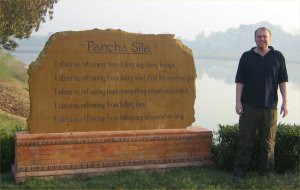 |
Buddhists undertake certain precepts as aids on the path to coming into contact with ultimate reality. Lay people generally undertake five precepts. The five precepts are:
1. I undertake the precept to refrain from harming living creatures (killing).
2. I undertake the precept to refrain from taking that which is not freely given (stealing).
3. I undertake the precept to refrain from sexual misconduct.
4. I undertake the precept to refrain from incorrect speech (lying, harsh language, slander, idle chit-chat).
5. I undertake the precept to refrain from intoxicants which lead to loss of mindfulness. |
| Bodhi tree and pond at Lumbini
The Lord Buddha sat under a tree like this on the night he attained enlightenment. The tree itself was a type of fig with the botanical name Ficus religiosa. In the centuries after the Buddha, the Bodhi tree became a symbol of the Buddha’s presence and an object of worship.
Many temples throughout the Buddhist world have Bodhi trees growing in them which are or are believed to be offspring of the one from Anaradapura and their worship forms an important part of popular Buddhist piety. |
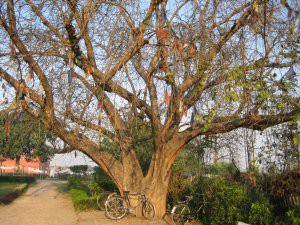 |
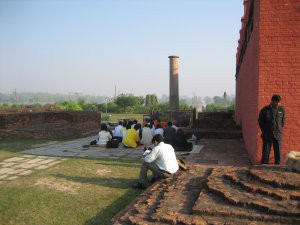 |
The exact location of the Birthplace of Buddha, remained uncertain and obscure till December the 1st 1886 when a wandering German archaeologist Dr Alois A. Fuhrer came across a stone pillar.
Historians now know this to be the Ashokan Pillar featured in the centre of this picture. |
| To the south of the Pillar is a garden with the sacred pool (Puskarni), believed to be the same pool in which Maya Devi took a holy dip just before giving birth to the Lord and also where infant Buddha was given his first purification bath.
In the background is another Bodhi Tree, and many fluttering prayer flags.
Prayer flags are actually colourful cotton cloth squares in white, blue, yellow, green, and red. Woodblocks are used to decorate the prayer flags with images, mantras, and prayers. |
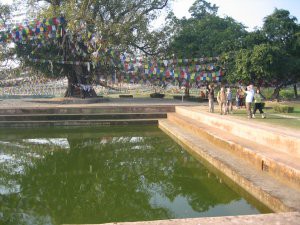 |
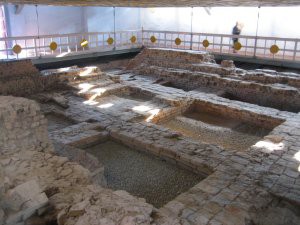 |
The foundations of the original birthplace of Buddha inside Mayadevi temple. There is a marker stone, showing the exact spot where he was born.
The site was Revealed after a hard and meticulous excavations under the three layers of ruins on top of the site.
I took this picture inside, as the building constructed around it, to protect it from the elements, looked (sadly) much like a red children’s fort and was most uninspiring. |
| Our guide showed us this temple.
It is possible to go there for a week, and “study” enlightenment.
This involves 7 days of not speaking a word. It was joked that I would struggle to complete this.
Our guide pointed out that they would prepare you in advance and you would get lots of meditation practice first. |
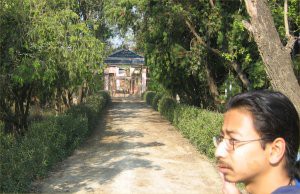 |
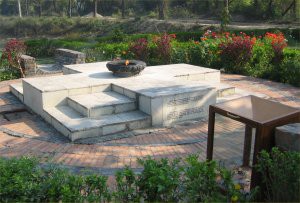 |
Eternal peace flame directly on the Canal, near the world peace pagoda. |
| The Korean Monastery still under construction.
This had the look of many of the “Soviet” buildings I had seen in China and Vietnam, and didn’t strike me as in any way, religious or enlightening. |
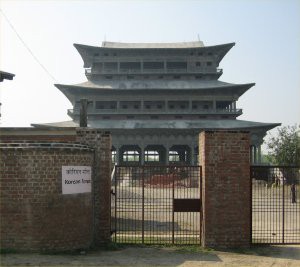 |
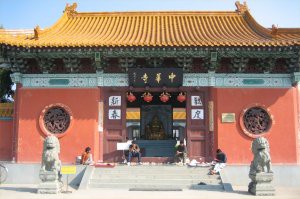 |
I’m not exactly sure, but I think this is the entrance to the Chinese temple.
I took the picture specifically because of the 2 lions outside. |
| Each lions mouth contains a ball, and its said to be impossible to remove it (some kind of Arthurian legend perhaps). |
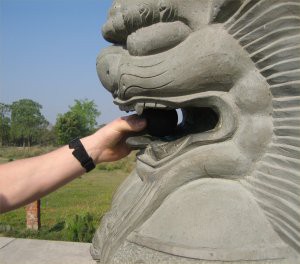 |
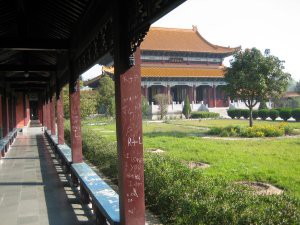 |
Inside the Chinese Maitreya Temple. |
| Our crew pose for a snapshot, on the steps outside the the main hall, of the Chinese monastery. |
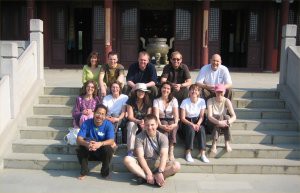 |